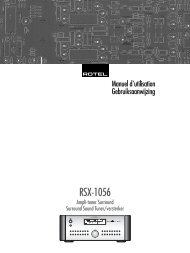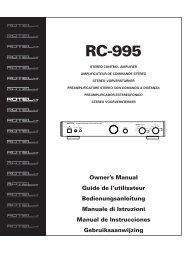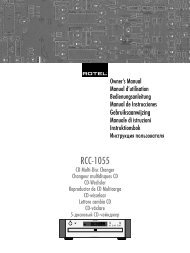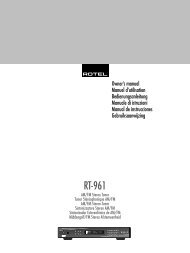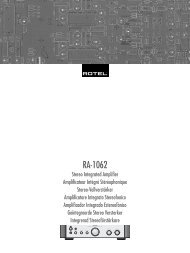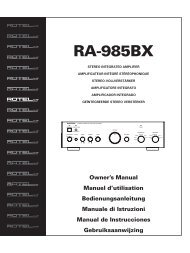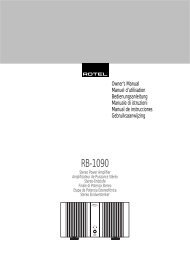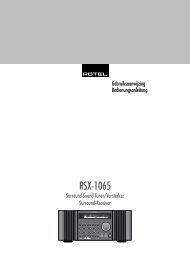Create successful ePaper yourself
Turn your PDF publications into a flip-book with our unique Google optimized e-Paper software.
35 English<br />
channel information is sent to the center<br />
speaker. The maximum setting of 7 shifts all<br />
of the center channel signal to the left and<br />
right speakers, essentially muting the center<br />
speaker and maximizing the soundfield width.<br />
Other settings provide incremental steps between<br />
the two extremes.<br />
When you have completed all the desired<br />
adjustments, highlight the INPUT SETUP MENU<br />
line at the bottom of the screen and press the<br />
ENTER button to return to the INPUT SETUP<br />
menu (or just press the ENTER button).<br />
DTS Neo:6<br />
DTS Neo:6<br />
MODE:Cinema<br />
INPUT SETUP MENU<br />
When DTS Neo:6 is selected as the default<br />
surround mode on the INPUT SETUP menu,<br />
there are additional option settings and parameters<br />
available to optimize the surround<br />
decoding for various types of recordings, music<br />
or movie soundtracks. DTS Neo:6 uses matrix<br />
decoding algorithms to derive a center<br />
channel and surround channels from 2-channel<br />
source material.<br />
In DTS Neo:6 surround mode, there will only<br />
be one choice available on the sub-menu:<br />
selecting CINEMA or MUSIC modes. Use the<br />
+/– buttons on the remote to change the settings.<br />
• Select CINEMA to optimize the DTS Neo:6<br />
decoding for movie soundtracks.<br />
• Select MUSIC to optimize the DTS Neo:6<br />
decoding for musical recordings.<br />
When you have completed the setting, highlight<br />
the INPUT SETUP MENU line at the bottom<br />
of the screen and press the ENTER button<br />
to return to the INPUT SETUP menu (or just<br />
press the ENTER button).<br />
Configuring<br />
Speakers and Audio<br />
This section of the setup process covers items<br />
concerning audio reproduction such as the<br />
number of speakers, bass management including<br />
subwoofer crossovers, establishing equal<br />
output levels for all channels, delay settings,<br />
and tone contour settings.<br />
Understanding Speaker<br />
Configuration<br />
Home theater systems vary in the number of<br />
speakers and the bass capabilities of those<br />
speakers. The <strong>RSP</strong>-<strong>1068</strong> offers surround modes<br />
tailored to systems with various numbers of<br />
speakers and bass management features which<br />
send bass information to the speaker(s) best<br />
able to handle it – subwoofers and/or large<br />
speakers. For optimum performance, you must<br />
tell the <strong>RSP</strong>-<strong>1068</strong> the number of speakers in<br />
your system and how bass should be distributed<br />
among them.<br />
NOTE: There are two types of bass in a surround<br />
system. The first is bass recorded in each<br />
of the main channels (front, center, and surround).<br />
This bass is present in all recordings<br />
and soundtracks. In addition, Dolby Digital 5.1<br />
and DTS 5.1 recordings may have a Low Frequency<br />
Effects (LFE) channel – the .1 channel.<br />
This LFE channel, typically played by a subwoofer,<br />
is used for effects such as explosions<br />
or rumble. The use of the LFE channel will vary<br />
from soundtrack to soundtrack. Recordings that<br />
are not encoded in Dolby Digital or DTS do<br />
not have the LFE channel.<br />
The following configuration instructions refer to<br />
LARGE and SMALL speakers, referring more<br />
to their desired bass configuration than their<br />
physical size. Specifically, use the LARGE setting<br />
for speakers that you want to play deep<br />
bass signals. Use the SMALL designation for<br />
speakers that would benefit from having their<br />
bass sent to more capable speakers. The bass<br />
management system redirects bass information<br />
away from all SMALL speakers and sends it to<br />
the LARGE speakers and/or the SUBWOOFER.<br />
It may be useful to think of LARGE as “full-range”<br />
and SMALL as “high-pass filtered.”<br />
Four typical examples of the many possible<br />
system configurations illustrate the principles<br />
behind bass management:<br />
• Five LARGE speakers and subwoofer:<br />
This system requires no bass redirection.<br />
All five speakers play the normal<br />
bass recorded in their respective channels.<br />
The subwoofer plays only the LFE<br />
channel bass. Depending on the<br />
soundtrack, there may be minimal use of<br />
the LFE channel, so the subwoofer would<br />
be under utilized. Meanwhile the normal<br />
bass places higher demands on the capabilities<br />
of the other speakers and the amplifiers<br />
driving them.<br />
• LARGE front, center, surround<br />
speakers, no subwoofer. The normal<br />
bass from the front, center, and surround<br />
channels is played in its respective speakers.<br />
With no subwoofer, the LFE bass is redirected<br />
to all five LARGE speakers. This<br />
places significant demands on these speakers<br />
and their amplifiers, as they must play<br />
their own normal bass plus the very demanding<br />
LFE bass.<br />
• All SMALL speakers and subwoofer.<br />
The normal bass from all channels is redirected<br />
to the subwoofer, which also plays<br />
the LFE channel. The subwoofer handles<br />
ALL of the bass in the system. This configuration<br />
provides several benefits: deep bass<br />
is played by the speaker most suited to do<br />
so, the main speakers may play louder with<br />
less distortion, and the need for amplifier<br />
power is reduced. This configuration should<br />
be used with bookshelf-size or smaller main<br />
speakers. It should also be considered in<br />
some cases with floorstanding front speakers.<br />
This configuration is advantageous<br />
when driving the system with moderate<br />
power amplifiers.<br />
• LARGE front speakers, SMALL center<br />
and surround speakers, and a<br />
subwoofer. The normal bass from the<br />
SMALL center and surround speakers is redirected<br />
to the LARGE front speakers and<br />
the subwoofer. The LARGE front speakers<br />
play their own normal bass plus the redirected<br />
bass from the SMALL speakers and<br />
LFE bass. The subwoofer plays the LFE bass<br />
plus the redirected bass from all of the other<br />
channels. This might be an appropriate configuration<br />
with a pair of very capable front<br />
speakers driven by a large power amplifier.<br />
A potential disadvantage with mixed<br />
LARGE and SMALL configurations is that<br />
the bass response may not be as consistent<br />
from channel to channel as it might<br />
be with the all SMALL configuration.



